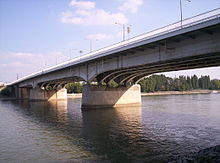Árpád Bridge
| Árpád Bridge | |
|---|---|
 |
|
| Carries | 2*3 roads+tram |
| Crosses | Danube River |
| Locale | Budapest |
| Official name | Árpád híd |
| Characteristics | |
| Design | Beam bridge |
| Total length | 981 meters (3,219 ft) |
| Width | 27.6 meters (91 m) |
| Longest span | 457.2 meters (1,500 ft) |
| History | |
| Opened | November 7, 1950 |
| Statistics | |
| Daily traffic | 150,000 |
Árpád Bridge or Árpád híd is a bridge in Budapest, Hungary, connecting northern Buda (Óbuda) and Pest across the Danube.
It is the longest bridge in Hungary, spanning about 2 km (1.24 mi) with the sections leading up to the bridge, and 928 m (0.58 mi) without them. It is 35.3 m (116 ft) wide with pedestrian and bicycle paths.
At its Óbuda end is Flórián tér, Szentlélek tér (near the Main Square of Óbuda, the Vasarely and Kassák Museums).
Margaret Island is connected to Árpád Bridge through an embranchment approximately in the middle of the bridge, and crosses the Southern tip of Óbuda Island as well, although there is no road, pedestrian or any other connection whatsoever between the two. (See Sziget Festival)
At the Pest end, the adjoining Line 3 (North-South) metro station is also called "Árpád híd".
In earlier times was there a bridge, what has been established by the Romans. It was linked a fort and the Aquincum. There was a plan at the beginning of the 19th century, to create a new bridge named Árpád. However the tender was announced only in 1929.
Construction began in 1939 by the plans of János Kossalka. It was planned to be named "Árpád Bridge" after Grand Prince Árpád, the second Grand Prince of the Magyars.
Due to World War II, the bridge was finished only after the war in 1950. Because of the communist regime then ruling Hungary, the bridge was opened as Stalin Bridge (Hungarian: Sztálin híd). The final construction works were directed by Károly Széchy and Pál Sávoly.
...
Wikipedia
